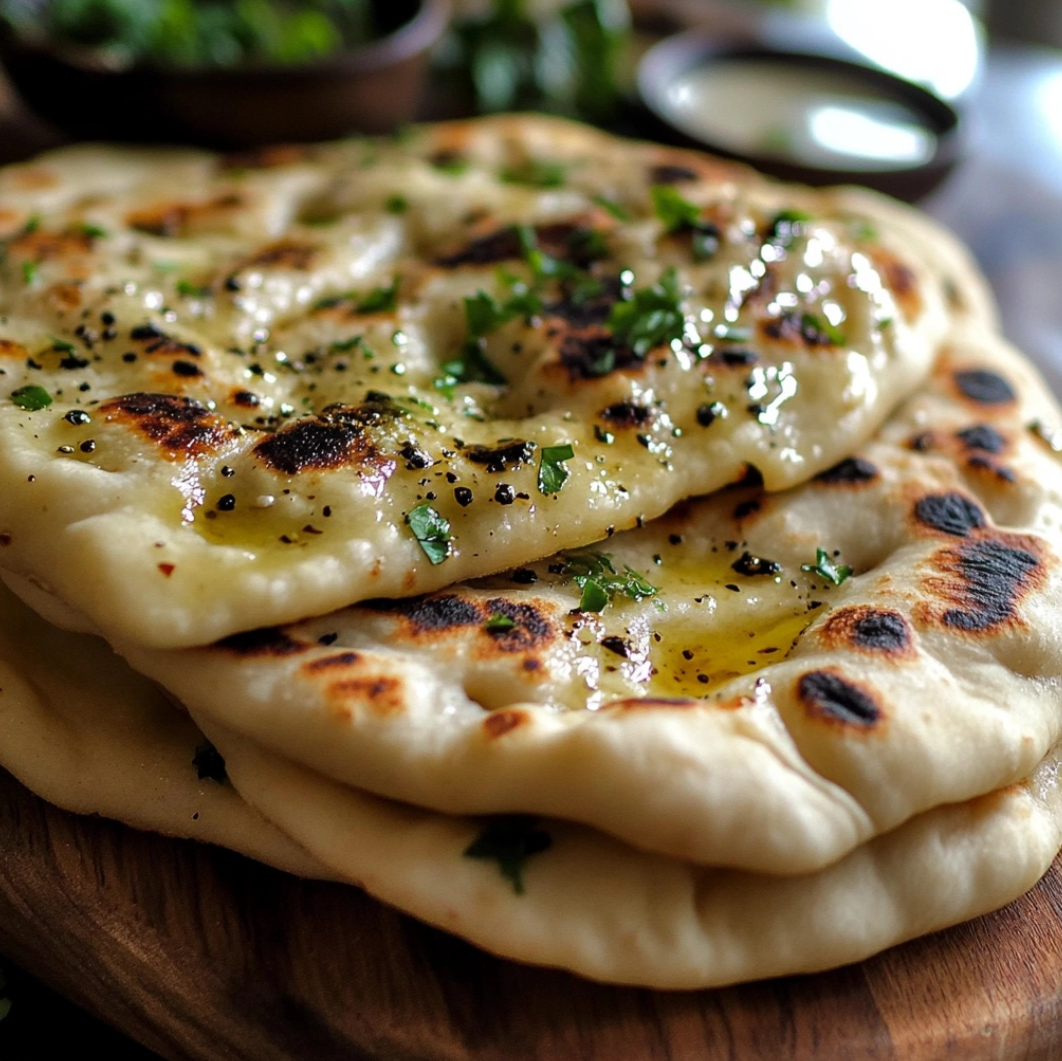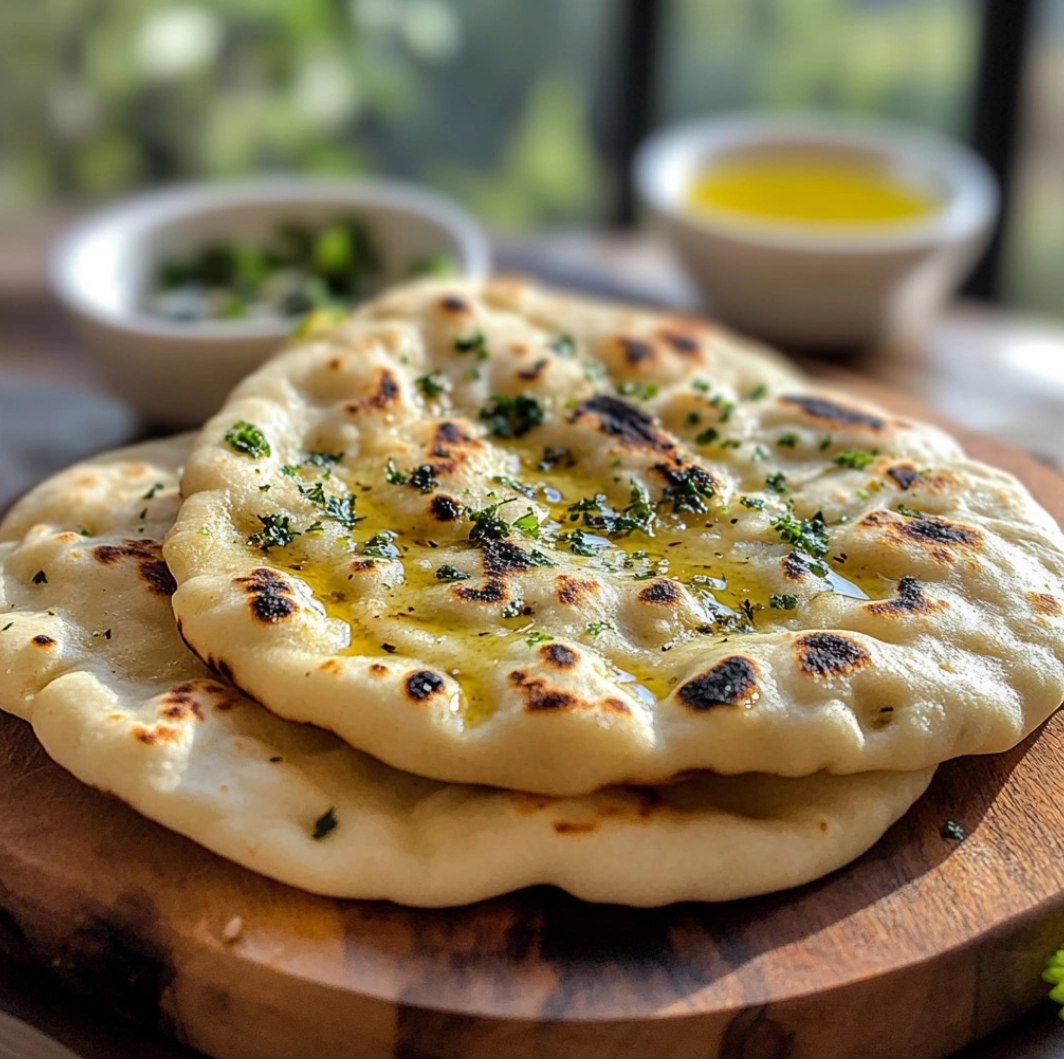Introduction
Naan bread is a beloved staple in Indian cuisine, known for its soft texture and delightful flavor. Traditionally baked in a tandoor, naan has found its way into kitchens around the world, allowing home cooks to recreate this delicious flatbread with relative ease. Making naan at home can seem daunting, but with the right ingredients and techniques, you can achieve restaurant-quality results in your own kitchen. This article will guide you through the entire process of making homemade naan, from the basic recipe to advanced techniques, maintenance tips, dietary adaptations, and answers to common FAQs.

Basic Recipe
Ingredients
- 1 tsp sugar
- 1 tsp active dry yeast
- 1 cup warm water
- 1 large egg
- 1 tsp salt
- 2 tbsp oil
- 1/2 cup yogurt
- 2 cups all-purpose flour
- Additional flour for kneading
Instructions
- Activate the Yeast: In a bowl, mix together the sugar, yeast, and warm water. Let this mixture sit for about 10 minutes until it becomes bubbly and frothy—this step is crucial for achieving fluffy naan!
- Combine Ingredients: Once the yeast is activated, add the egg, salt, oil, and yogurt to the mixture. Stir well to combine all ingredients.
- Form the Dough: Gradually fold in the flour until you have a sticky dough. Don’t be afraid to get your hands dirty!
- Knead the Dough: Transfer the dough to a floured surface and knead for about 10 minutes. You want the dough to be smooth and elastic; add more flour if needed to reach this texture.
- Let It Rise: Place the kneaded dough into a lightly greased bowl, cover it with a damp cloth, and allow it to rise in a warm area for about an hour, or until it doubles in size. This patience is key for soft naan!
- Preheat the Cooking Surface: While the dough rises, preheat a skillet or tandoor over medium-high heat to ensure a perfect cook on your naan.
- Shape the Naan: Once the dough has risen, punch it down and divide it into 6-8 equal portions. Roll each piece into a ball, then flatten them into ovals or rounds about 1/4 inch thick.
- Cook the Naan: Place each piece of naan in the hot skillet for 2-3 minutes on each side, or until they puff up and develop a beautiful golden color.
- Finish with Butter: For an extra indulgent touch, brush your naan with melted butter or garlic butter just before serving. Your taste buds will thank you!
Serving Suggestions
Enjoy your warm, delicious homemade naan with your favorite curry, as a side to any meal, or even with dips for a delightful snack!
Advanced Techniques
Perfecting Your Naan
To truly elevate your homemade naan, consider these advanced techniques that can enhance flavor and texture:
1. Use a Tandoor or Pizza Stone
If you have access to a tandoor, nothing beats the authentic flavor that comes from cooking naan in it. If not, a pizza stone in your oven can mimic this effect. Preheat the stone in your oven at the highest setting for at least 30 minutes before cooking the naan.
2. Experiment with Flavors
Add ingredients like minced garlic, chopped herbs, or spices to your dough for extra flavor. Incorporating ingredients like nigella seeds or sesame seeds on top before cooking can also add a delightful crunch.
3. Use Yogurt Variations
Substituting some of the yogurt with a thicker yogurt, like Greek yogurt, can add creaminess to your naan. Alternatively, using flavored yogurt can introduce unique tastes to your bread.
4. Practice the Art of Tossing
For a truly authentic experience, try tossing the naan in the air while shaping it. This method helps to stretch the dough evenly and adds a rustic touch.
5. Achieving the Right Puff
The key to a perfectly puffy naan lies in the cooking temperature and timing. Ensure your skillet or oven is hot enough and avoid overcrowding your cooking surface to allow each piece to puff up beautifully.

Maintenance Tips
Storing Leftover Naan
To keep your homemade naan fresh, follow these maintenance tips:
1. Room Temperature Storage
If you plan to eat your naan within a day, simply store it at room temperature in an airtight container or wrapped in a kitchen towel. This helps retain moisture and prevents the bread from drying out.
2. Refrigeration
For longer storage, refrigerate the naan. Place it in a zip-lock bag or airtight container, separating layers with parchment paper to prevent sticking. Consume within 3-4 days for the best taste.
3. Freezing Naan
For even longer storage, freeze your naan. Wrap each piece individually in plastic wrap and place them in a freezer-safe bag. Naan can be frozen for up to 3 months. To reheat, simply thaw and warm on a skillet.
4. Reheating Techniques
When reheating, avoid the microwave as it can make naan chewy. Instead, warm it in a skillet over medium heat for a few minutes on each side, or place it in a preheated oven wrapped in foil until heated through.
Dietary Adaptations
Making Naan for Different Diets
Homemade naan can easily be adapted to fit various dietary needs. Here are some suggestions:
1. Gluten-Free Naan
To make a gluten-free version, substitute all-purpose flour with a gluten-free flour blend. Make sure to add a binding agent like xanthan gum to help achieve the right texture.
2. Vegan Naan
For a vegan adaptation, omit the egg and substitute yogurt with plant-based yogurt. Use vegetable oil instead of any animal-based fats to keep it fully plant-based.
3. Low-Carb Naan
For a low-carb version, consider using almond flour or coconut flour. Keep in mind that the texture and flavor may differ slightly from traditional naan.
4. Flavor Enhancements
Incorporate spices or herbs into the dough for added flavor while maintaining dietary restrictions. Options like turmeric, cumin, or dried herbs can create a delicious twist.

FAQs
Common Questions About Naan Bread
1. Why is my naan not puffing up?
Naan may not puff up if the skillet is not hot enough or if the dough has not been allowed to rise adequately. Ensure the cooking surface is preheated and give the dough enough time to rise.
2. Can I make naan without yeast?
Yes! You can make a yeast-free version using baking powder as a leavening agent. Substitute 1 tsp of baking powder for the yeast and follow a similar recipe.
3. How can I add flavors to my naan?
Experiment with adding minced garlic, herbs, or spices to your dough before cooking. You can also brush flavored butter on top after cooking for extra taste.
4. What can I serve with naan?
Naan pairs wonderfully with a variety of dishes such as curries, stews, soups, and dips. It’s also delicious with hummus or as a side to grilled meats and vegetables.
5. Is naan bread healthy?
Naan can be part of a balanced diet when consumed in moderation. It is rich in carbohydrates, but you can make it healthier by using whole grain flour or adding seeds for extra nutrition.
Conclusion
Making homemade naan bread is a rewarding culinary adventure that can elevate your meals and impress your family and friends. With a few simple ingredients and techniques, you can create soft, fluffy naan that pairs perfectly with your favorite dishes. Whether you’re exploring advanced cooking methods, adapting the recipe to meet dietary needs, or simply enjoying the basics, naan is a versatile bread that brings comfort and joy to any table. Enjoy your baking journey and savor the delicious results!

